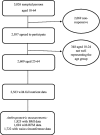Higher ultra-processed food consumption is associated with poor nutritional quality but not with obesity in Israeli adults
- PMID: 40529411
- PMCID: PMC12170302
- DOI: 10.3389/fnut.2025.1586611
Higher ultra-processed food consumption is associated with poor nutritional quality but not with obesity in Israeli adults
Abstract
Introduction: Ultra-processed foods (UPF) intake has increased in recent decades, coinciding with declines in diet quality, nutritional sufficiency, and rises in obesity and chronic diseases. Understanding its impact on health outcomes is crucial.
Methods: This secondary analysis of Israel's cross-sectional study, 2014-2016 National Health and Nutrition Survey includes 2,563 adults (25-64 years) with full dietary data. Data was obtained by a 24-hour recall based on an interview for dietary intake data, and anthropometric measurements such as weight, height, and waist circumference (WC). UPF consumption (percentage of total energy intake) was calculated classifying reported foods into four groups according to the NOVA method, based on their processing level. Diet quality was assessed by food group and nutrient intake by UPF consumption levels, while obesity was defined using BMI (≥30), relative fat mass, and waist circumference. Associations were tested using the chi-square test, the Cochran-Armitage trend test for dichotomous variables, and the Cochran-Mantel-Haenszel test for trend analysis across three or more categories. Additionally, logistic regression models were employed to account for potential confounders.
Results: Participants were 46.8% men, average age 42.2 ± 11.1 years, with mean UPF consumption at 34.5% of total energy intake. Upper quartile UPF consumption was associated with younger age (p = 0.0015), low physical activity (p < 0.001) and smoking (p = 0.0162). Higher consumption of UPF was associated with high intake of energy, carbohydrates, saturated fat, and thiamine (p < 0.0001). It was also significantly linked to lower total intake of fat, protein, monounsaturated fatty acids, dietary fiber, folic acid, vitamin B12, vitamin C, and zinc. No significant association was found between UPF consumption and obesity (N = 1825).
Discussion: UPF consumption is negatively correlated with nutrition quality but not with obesity among Israeli adults. Future obesity studies should thoroughly examine the etiological role of UPF. Furthermore, effective strategies should be developed to lower the level of processing in the food industry and to reduce the consumption of UPF.
Keywords: 24 hour-recall; MABAT; NOVA; diet quality; nutrients.
Copyright © 2025 Shimony, Rosenberg, Keinan-Boker and Shahar.
Conflict of interest statement
The authors declare that the research was conducted in the absence of any commercial or financial relationships that could be construed as a potential conflict of interest.
Figures




References
-
- WHO . The Global Health Observatory. Available online at: https://www.who.int/data/gho/data/indicators/indicator-details/GHO/preva... (Accessed February 29, 2024).
LinkOut - more resources
Full Text Sources

